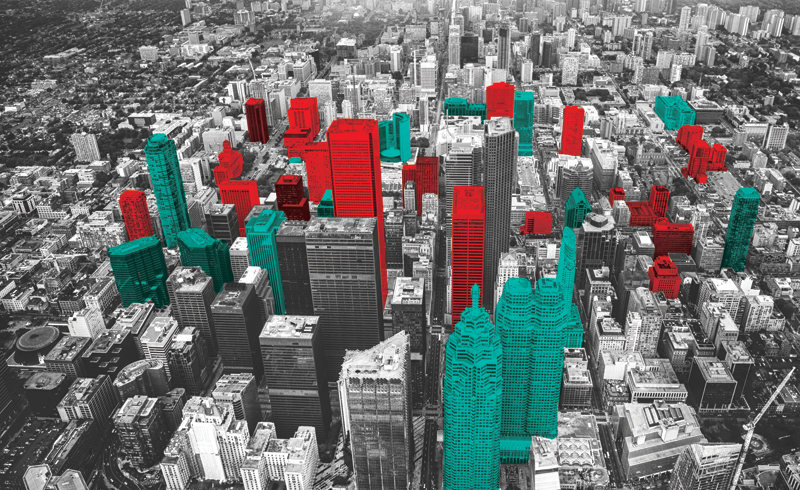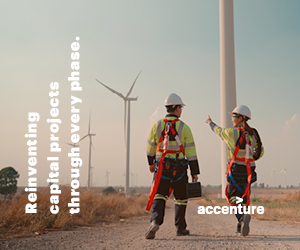If the first decade of the 2000s brought green building to the mainstream through programs like LEED and BOMA BESt (Building Environmental Standards), then the current decade may well be the era of sustainable communities. Transit-oriented development, community energy planning, neighbourhood certifications like LEED-ND, and district sustainability initiatives all speak to the understanding that we need a more integrated approach to tackling the challenges faced by our cities.
In Toronto, like much of North America, greenhouse gas (GHG) emission reductions represent one of the biggest challenges. The targets are ambitious—both the City of Toronto and the Province of Ontario have called for deep GHG reductions of 80 per cent by 2050—and nearly everyone in the city contributes to the problem either through the buildings where they live and work, or how they move about the city.
A key challenge for planners, policymakers, conservation groups, and community members is that, despite a huge amount of information on emissions quantities, we have a lack of context as to why those emissions are generated. The convergence of big data (how we understand our impacts) and engagement (how we effect change) is one of the greatest opportunities for market transformation available to us. Without this big picture understanding, how can we effectively evaluate impact potential, share responsibility, and focus limited resources where they will have the greatest impact?
In April 2015, the Toronto 2030 District became the first Canadian member in a network of North American cities focused on deep urban GHG emissions reductions. District sustainability initiatives, like 2030 Districts, Eco-Districts, and Green Zones, typically address market transformation through an integrated community-wide approach that sets targets and engages stakeholders to take achievable actions when possible, or unite to address systemic issues like data and process standardization, policy change, or public engagement.
One of the first goals of the initiative was to assess the whole district and try to understand both the current conservation landscape in Toronto and how it overlapped with the emissions profile for the city. Founded by the Ontario Association of Architects and Sustainable Buildings Canada, the district’s early partners had a lot of information on building performance, but little experience in geographic aggregation of utility consumption. So, they engaged the Canadian Urban Institute, which has supported, among others, Hamilton’s Horizon Utilities in mapping energy density.
What was uncovered was both good and bad. On the positive side, there is a lot of information about how buildings perform, and the market capacity to improve building performance has grown tremendously. Significant achievements were driven by programs like the Race to Reduce, which encouraged commercial landlords to cut energy consumption by 10 per cent over four years. These voluntary programs demonstrate the potential for performance data to inform building owners on priority areas for improvement, provide comparative benchmarking within a peer group, and motivate participants through the accountability brought on by reporting.
Despite having significant impact and gathering useful building data, voluntary program participation tends to be skewed toward the top end of the market, both in terms of building asset class and building management capability. This suggests the aggregated performance outlook is also better than the true average for the market, although it’s difficult to quantify by how much. We are lacking in our ability to see this information as it relates to the entire urban resource system and, by extension, the emissions of the whole community.
This includes comparisons across building types, between participants and non-participants, consumption profiles for clusters of buildings, or variations by time of day. Most importantly, we can’t see how changes to one part of the system impact the other parts of the system. Very little information on buildings that do not participate in voluntary programs is available to anyone other than the building owners. The data these programs do collect typically rest in sector silos, each with its own taxonomy and structure with little accessibility to outsiders or applicability beyond the original narrow program focus.
Even the utilities have very little information about individual buildings (size, use, scheduling, and other fuel types) that would let them translate meter readings into a useful tool for identifying conservation opportunities.
For real strategic planning at a regional level, we need a combination of these two groups of data: building specific data and aggregated utility data in a common platform.
The answer may lie in the creation of integrated urban models that present a more complete perspective of energy, water, and transportation systems. These models serve as a tool for understanding overall emissions and to more effectively analyze direct and indirect effects of policies and programs.
To demonstrate the potential of urban energy modelling, we can look to a suite of recent research projects from Europe including EECITIES (eecities.com), based on the European Commission funded SEMANCO project, and the Urban Energy Systems project (imperial.ac.uk/urbanenergysystems) out of Imperial College in London, England. These models focus on aggregating data sources, including geographic information, building information, utility information, and activity patterns, into a single platform where the data can be manipulated and communicated to support planning activities.
Pilot projects in Spain, the United Kingdom, and Denmark have confirmed a number of potential applications. These include:
- Comparing the cost-benefit of different energy and water conservation strategies;
- Targeting government and utility subsidies to the areas of biggest impact and where financial support is needed most;
- Helping building owners identify and assess options to reduce energy demand;
- Establishing building category baselines for energy and water performance;
- Forecasting infrastructure, energy, and water requirements for new developments;
- Evaluating different energy supply options in new developments;
- Identifying district energy opportunities by analyzing energy use in building clusters; and
- Facilitating the ability for municipalities and conservation agencies to report on progress toward conservation goals.
Developing integrated urban system models is not without its significant challenges. Each sub-system data layer was likely developed on a unique platform with one of many programming languages. The data collection time periods and geographic scales may vary. Much of the data will be protected under some sort of confidentiality agreement and appropriate privacy and data security measures must be in place. Finally, some of the data will not exist at all.
Even once the framework is in place, data entry and validation is an ongoing challenge. But these challenges are not insurmountable. Mandatory building energy reporting requirements in many U.S. cities and currently under evaluation in Ontario would greatly increase the availability of building performance data in a standard and consistent format, with some level of compliance auditing built in to validate the accuracy of the data. From the utility data side, programs like MaRS’ Green Button, which provides customer electricity data in a standardized digital format, begins to grant third parties permission-based access to data automatically through customizable application programming interfaces.
The key players in urban energy modelling include public and private utilities, city building and planning departments, property assessment agencies, and building owners. While getting them all to work together is a challenge, the benefit of an integrated energy model is worth the effort.
What is often required is a pilot opportunity to test the process in a limited way before fully investing in a platform to which initiatives like the Toronto 2030 District are particularly well suited.
Jeff Ranson is executive director of the Toronto 2030 District. He is also a lead facilitator for the Enbridge Savings By Design builder conservation program and was the lead instructor for the Canada Green Building Council’s Certified Sustainable Building Advisor program.












